While a good portion of California is dry and barren, the northern region stands out with its biodiversity of plants. With a diverse set of USDA climate zones from 5 to 10. Given the state’s size, it’s no surprise the state is often divided into northern and southern regions. In fact, many perennial flowers that thrive in Northern California will not grow in the southern part of the state due to the different climate and soil conditions.
If you’re a gardening novice or enthusiast in Northern California, choosing perennial flowers will guarantee colorful blossoms in your garden every year. In this article, we will introduce you to the finest perennials that thrive in Northern California, helping you to create a beautiful garden season after season. Let’s dive in!
1. Yerba Mansa (Anemopsis californica)
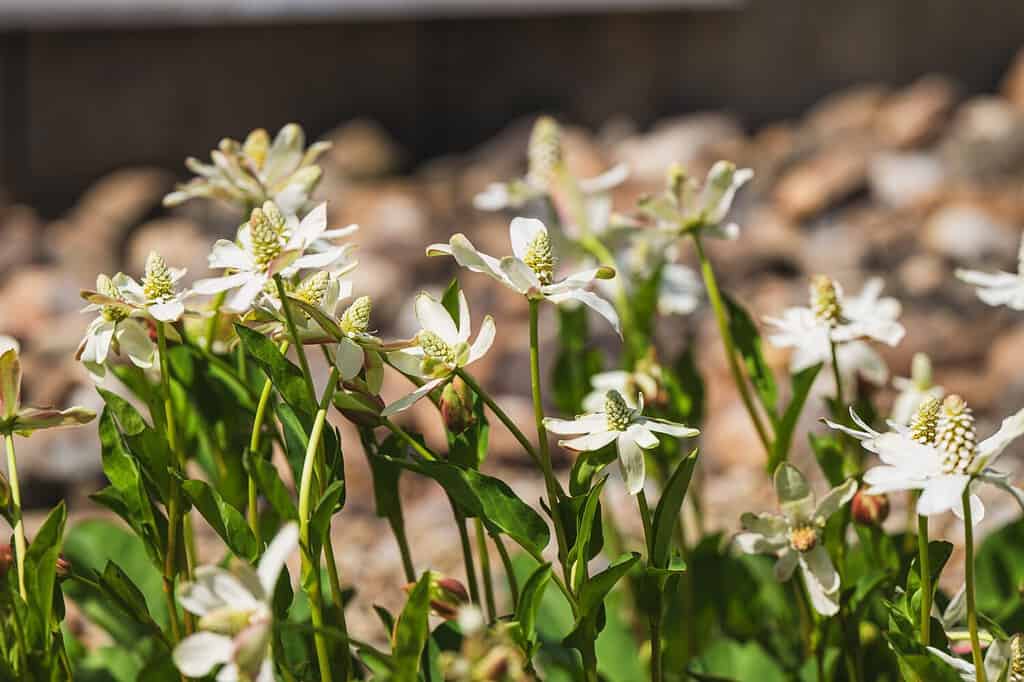
A common flower in Northern California is yerba mansa, which is a plant in the lizard’s tail family.
©Rudolf_Prchlik/Shutterstock.com
Yerba mansa is a lively perennial that spreads widely, showcasing upright floral columns in the warmer months. These columns slightly tower over the plant’s body, presenting small fragrant white blossoms bundled into a cone shape. Complementing these are between four and nine broad white bracts that resemble petals, sitting at each column’s base.
The leaves of the yerba mansa are notably large, meaty, and a rich shade of green, stretching up to 6 inches. They give off a distinct, spicy aroma. Interestingly, as temperatures drop, this plant shows off red hues, and by autumn, it turns a deep brick red. This beauty is ideal for water-edge settings, making it a lovely addition to ponds and wetland gardens in Northern California.
It thrives best in consistently damp soil, whether in direct sunlight or partial shade. If you want to grow it from seeds, it’s a good idea to start indoors once spring is in full swing and frosty threats are behind.
2. Elk Clover (Aralia californica)

These subtle flowers are common to the cooler regions of Northern California and attract pollinators.
©Post_Insignem/iStock via Getty Images
Elk clover is a large perennial flower that thrives in Northern California. This plant showcases grand stems that support its vast green leaves, some even reaching lengths of 6 feet and widths of 3 feet. At the end of these long, curving stems, you’ll find compound leaves consisting of three to five leaflets, collectively forming a shade akin to an umbrella. As autumn approaches, these leaves transform into a beautiful golden color before withering away.
Atop this leafy umbrella, you’ll find striking clusters of greenish-white flowers spanning 12-18 inches in summer and early autumn. These blossoms are a favorite among various pollinators, such as bees and butterflies.
Native to California and parts of southwestern Oregon, elk clover prefers the damp and shadowy corners, comfortably residing below elevations of 6,500 feet.
If you want to plant elk clover in your garden, ensure you place it in a moderately to fully shaded spot, with a liking for neutral to slightly acidic, damp, and well-aerated soils. Generally, spring, when the temperatures hover between 60°F and 85°F, is ideal for planting. But if you’re in a milder climate zone, late summer to early fall works just fine.
3. Showy Milkweed (Asclepias speciosa)
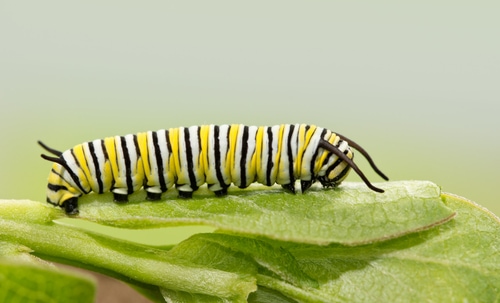
Milkweed is the favorite meal of the famous monarch
caterpillar
.
©Sari ONeal/Shutterstock.com
Ideal for Northern California gardens, showy milkweed is a bushy perennial flower recognized for its eye-catching globe-like clusters of aromatic, soft pinkish-white blossoms. These flowers make their grand appearance from late spring to early summer, offering a haven for butterflies, hummingbirds, and other insects. Emerging from the junctions of leaves and crowning the soft, upright stems, these flowers are surrounded by velvety, broad, blue-green leaves.
It’s not just an ornamental gem for gardens but also plays a pivotal role in nature. Specifically, milkweed plants serve as a lifeline for monarch butterflies. In fact, the monarch caterpillars almost exclusively eat milkweed. So, planting milkweed in your garden will likely attract many beautiful monarch caterpillars and eventually butterflies in late spring!
This plant loves bathing in direct sunlight and prefers soils that range from dry to moderately moist. It’s also pretty adaptive, thriving even in less fertile, gravel-laden terrains. One can easily grow showy milkweed from seeds or even through its rhizome cuttings. For those keen on planting, sowing its seeds outdoors during the fall or winter works wonders.
Fun fact: Native Americans have used milkweed for hundreds, if not thousands, of years. The strong fibers of this plant make great rope and clothing.
4. Elegant Cluster-Lily (Brodiaea elegans)
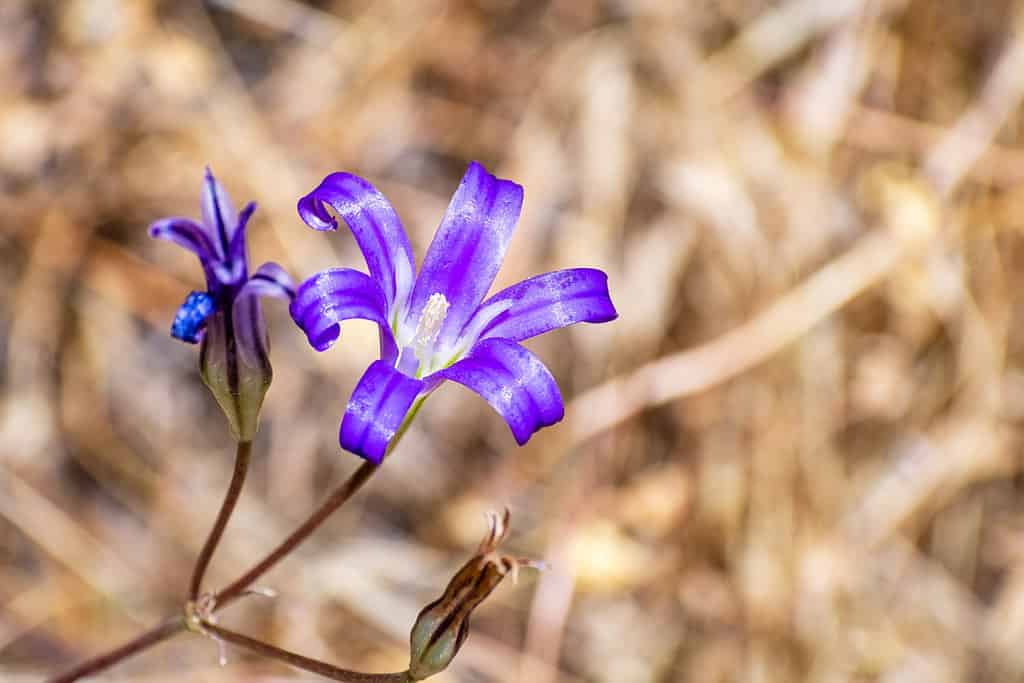
The elegant cluster-lily is a beautiful perennial flower that blooms at the beginning of summer.
©Sundry Photography/Shutterstock.com
An effortless delight for gardeners, the elegant cluster-lily is a bulb-based perennial with clusters of blue-violet or purple, bell-like flowers. These blooms typically emerge in late spring through mid-summer. Each bloom is characterized by six gracefully arching petals, contrasted by white, pointy, non-functional stamens and fully functional ones crowned with pronounced anthers. These blooms gracefully rise on sturdy, leaf-free stems, creating a delightful scene before the plant takes its summer rest.
Its slender leaves make an appearance in the latter part of winter, gracefully bowing out when the blossoms take center stage. Being drought-resistant and flexible in its needs, this delightful lily is a dream addition to gardens. Its roots trace back to the mountainous terrains of California.
This lily thrives in soils ranging from dry to moist and can adapt to clayey, well-draining grounds. Whether under the full embrace of the sun or in partial shade, it flourishes. For those eager to see its summer blooms, planting in spring or autumn is ideal.
5. Beach Primrose (Camissoniopsis cheiranthifolia)
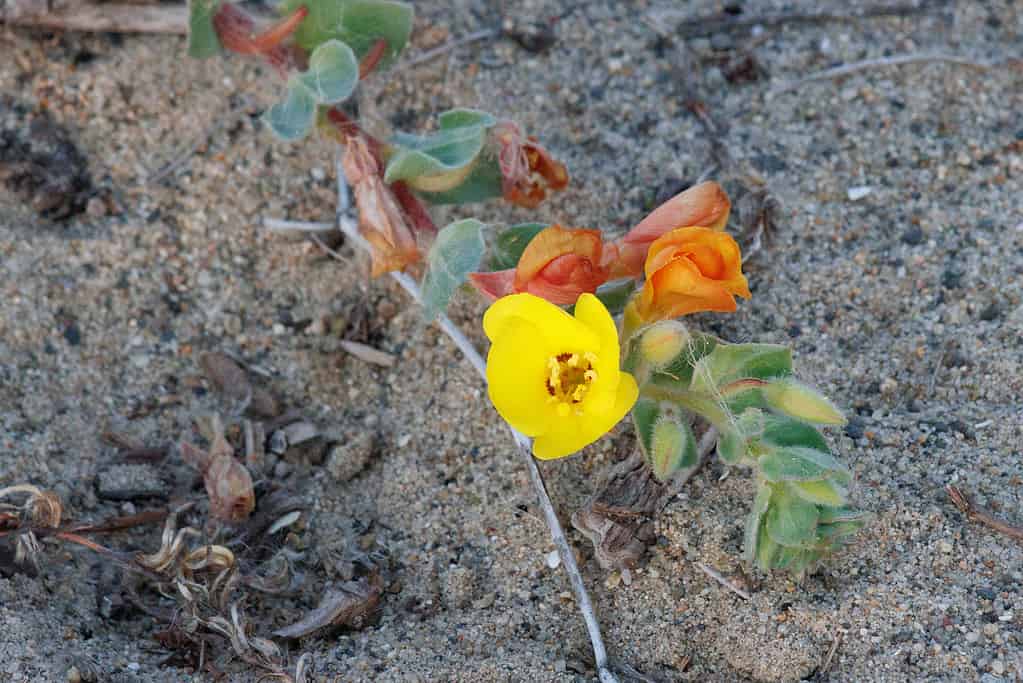
This flower thrives in the coastal areas of California and displays a beautiful, small yellow flower.
©Jared Quentin/iStock via Getty Images
As the name suggests, beach primrose is perfect for the sandy, coastal regions of Northern California. Beach primrose is a ground-hugging perennial flower that often forms dense carpets of silvery gray-green leaves with smooth edges. This plant exhibits vibrant yellow blossoms, about an inch or so in diameter, each boasting four radiant petals that greet the morning sun.
These flowers emerge from the junctions of wiry stems that remain close to the ground. As time progresses, the bright petals transition into shades of red or orange. These lovely blooms, often visited by butterflies, eventually yield slender, four-faceted seed capsules. When mature, these capsules burst, letting gravity and small creatures play their part in seed dispersal. Proudly calling the sandy soils of coastal California home, beach primrose is adept at thriving in some of the most challenging conditions.
While beach primrose has the potential to flower throughout the year with occasional summer watering, it’s best planted in sun-kissed, sandy, well-draining soils. For those looking to introduce it into their gardens, seeding in late fall or the onset of spring is ideal, whether in containers or directly at the desired spot.
Fun fact: This is a rare plant that is only found in distinct areas along the California and Oregon border at elevations of less than 500 feet. It is also rarely spotted more than a couple hundred feet from the beach.
6. Cobwebby Thistle (Cirsium occidentale)
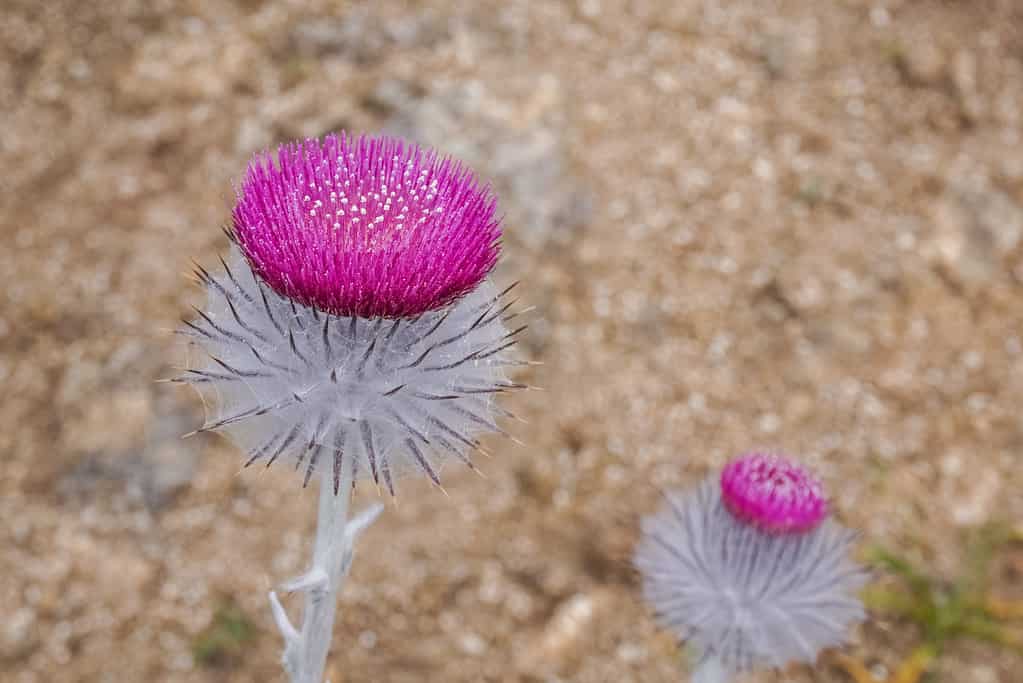
One of the most unique-looking plants on this list is the cobwebby thistle, which has a spiky and spiderweb-esque appearance
©Sundry Photography/iStock via Getty Images
Cobwebby thistle presents itself as a charming short-term perennial. It primarily forms a foundational rosette in its first year, while the following year is reserved for flowers. The sturdy vertical stem can either stand singularly or possess a few upward-reaching side branches. What captures attention is the plant’s unique covering of pale, long, silk-like fibers reminiscent of spider webs.
Its oval-shaped leaves, intricately divided with triangular segments and edged with sharp thorns, gracefully encircle the stem, sometimes flaunting thorny extensions.
One of its highlights is the plush, rose-purple flower clusters spanning up to three inches. These clusters comprise numerous tiny flowers nestled within thorny enclosures, all draped in a soft, white, wool-like texture. Offering a prolonged bloom period, these flowers are a pollen and nectar-rich haven for local bees and butterflies.
It flourishes best under generous sun or partial shade, favoring moderately dry, well-aerating soils. Planting seeds from early autumn to winter’s end is optimal. And if you’re seeding at the start of fall, a timely rain might just expedite the germination process.
7. Umbrella Plant (Darmera peltata)
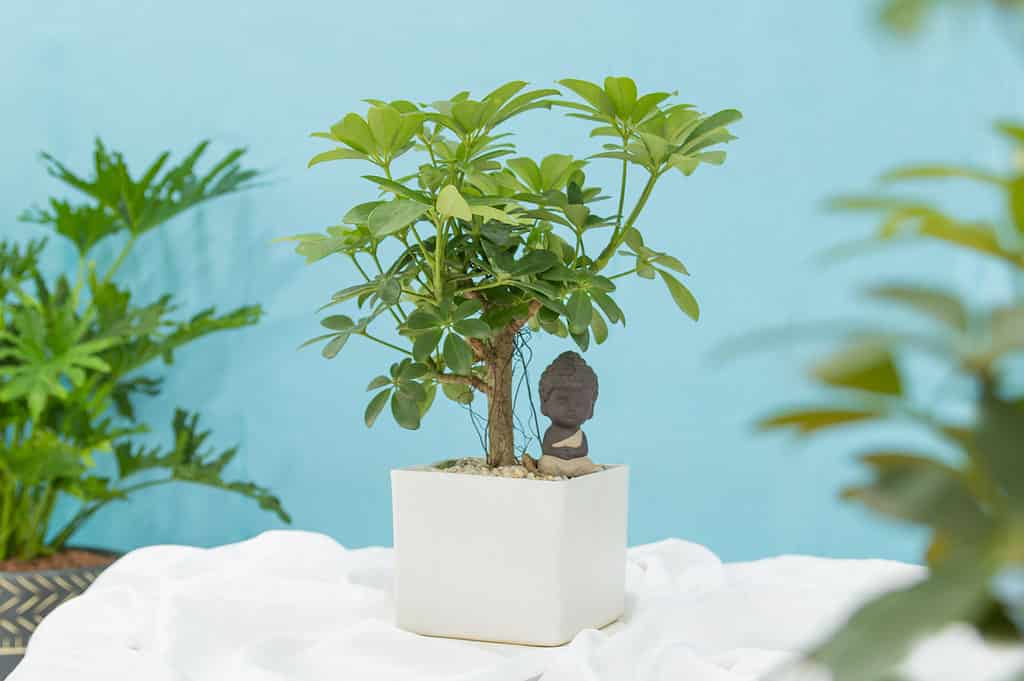
This is the dwarf version of the umbrella plant, which has been made into a cute bonsai tree.
©Mid Tran Designer/Shutterstock.com
The umbrella plant is an exceptional perennial flower that thrives in the warmer regions of Northern California. This flower is distinctively large and shiny, with round leaves that can spread up to 18 inches. While the tops of the leaves boast a deep green hue, their undersides are a lighter shade. When autumn comes around, the leaves of the umbrella plant change color before falling off to a beautiful range of orange, yellow, and red.
The leaves of the umbrella plant regrow in early spring, and during this time, the flowers come out to play! Clusters of delicate flowers, ranging from soft pink to pure white, on tall, slender stems emerge. These blossoms bear a resemblance to those of the Bergenia and continue to captivate even after the plant’s leaves have opened fully. It’s a prime choice for damp, shaded areas, especially near bodies of water like ponds or streams.
This plant has the esteemed Award of Garden Merit from the Royal Horticultural Society.
For optimal growth, the umbrella plant thrives in shaded areas, whether partial or complete, and it prefers soil that’s consistently moist or even waterlogged. If you’re looking to propagate this plant, you can either take cuttings or plant its seeds.
Fun fact: the umbrella plant is actually native to Taiwan and is popular in Asia, but it thrives in the warmer regions of Southern California and other regions of the USA because it is easy to take care of.
8. Californian Cyclamen (Dodecatheon hendersonii)
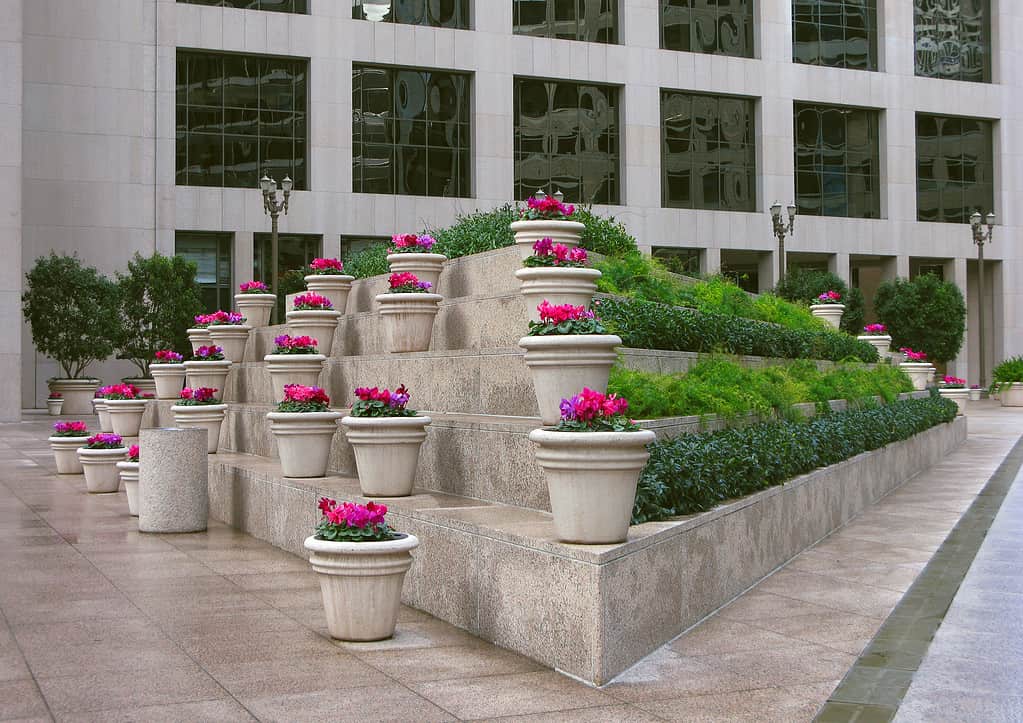
These colorful flowers, called Californian cyclamen are popular garden plants in Northern California.
©walencienne/iStock via Getty Images
The Californian cyclamen is a robust perennial that you can grow in Northern California. This plant grows bunches of 3-17 drooping flowers that vary from light to vibrant magenta-pink, each about an inch long. Their appearance is similar to traditional cyclamen flowers, characterized by four or five elegantly curved petals and a noticeable cluster of dark stamens, giving them a windswept look.
From mid-spring to early summer, these captivating flowers stand tall on sturdy, leaf-free stems emerging from a base of heart-shaped, rich green leaves. When a group of these plants is in full bloom, it truly is a visual treat and can enhance any garden space.
This plant has earned the respected Award of Garden Merit from the Royal Horticultural Society.
It flourishes ideally in areas with full sunlight to partial shade, especially in nutrient-dense, moist, and well-aerated soils. A good rule of thumb for planting cyclamens in California is to wait until the region hasn’t experienced frost for a couple of weeks.
9. Seaside Daisy (Erigeron glaucus)
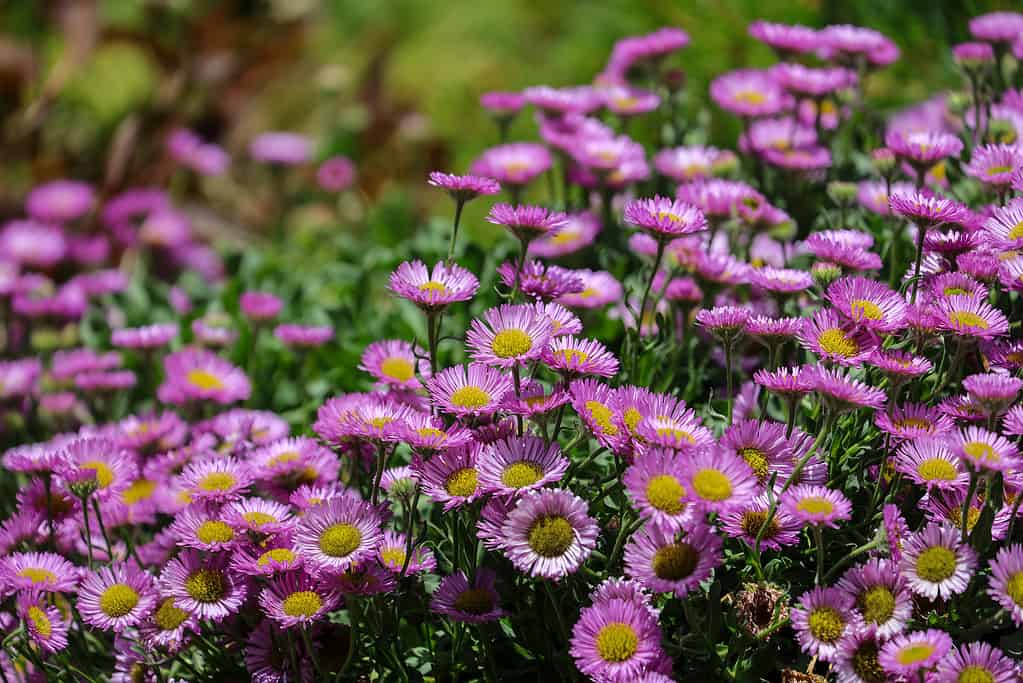
Seaside daisies are beautiful, low-lying, pink, and yellow perennial flowers that grow in the coastal regions of Northern California.
©yujie chen/iStock via Getty Images
Originally from the coasts of Northern California and southern Oregon, the seaside daisy is a perennial flower that showcases a lush display of semi-double lavender-pink flowers with yellow centers. These vibrant blooms nearly overshadow the plant’s tough, spoon-like, blue-green leaves from mid-spring to late summer.
It’s an ideal choice for coastal landscapes, gardens that attract butterflies, or as a dense ground cover. You can also use it to add charm to rock gardens or to fill gaps in pathways. Not only is this plant evergreen in regions with gentle winters, but it’s also deer-resistant and can withstand dry spells.
It thrives best in nutrient-rich soils that are moderately moist but have good drainage, and it can be positioned in anything from full sun to partial shade. If you’re interested in propagating the seaside daisy, you can do so either through stem cuttings or by splitting the plants at the onset of spring.
Fun fact: The seaside daisy is a fire-resistant plant, so it is a very handy flower to plant not only for its beauty but also for stopping the spread of wildfires. The daisy will not ignite and can act as a barrier against an oncoming wave of forest fire. This is especially an important issue to address in California, where wildfires ravage the state frequently.
10. Western Goldentop (Euthamia occidentalis)
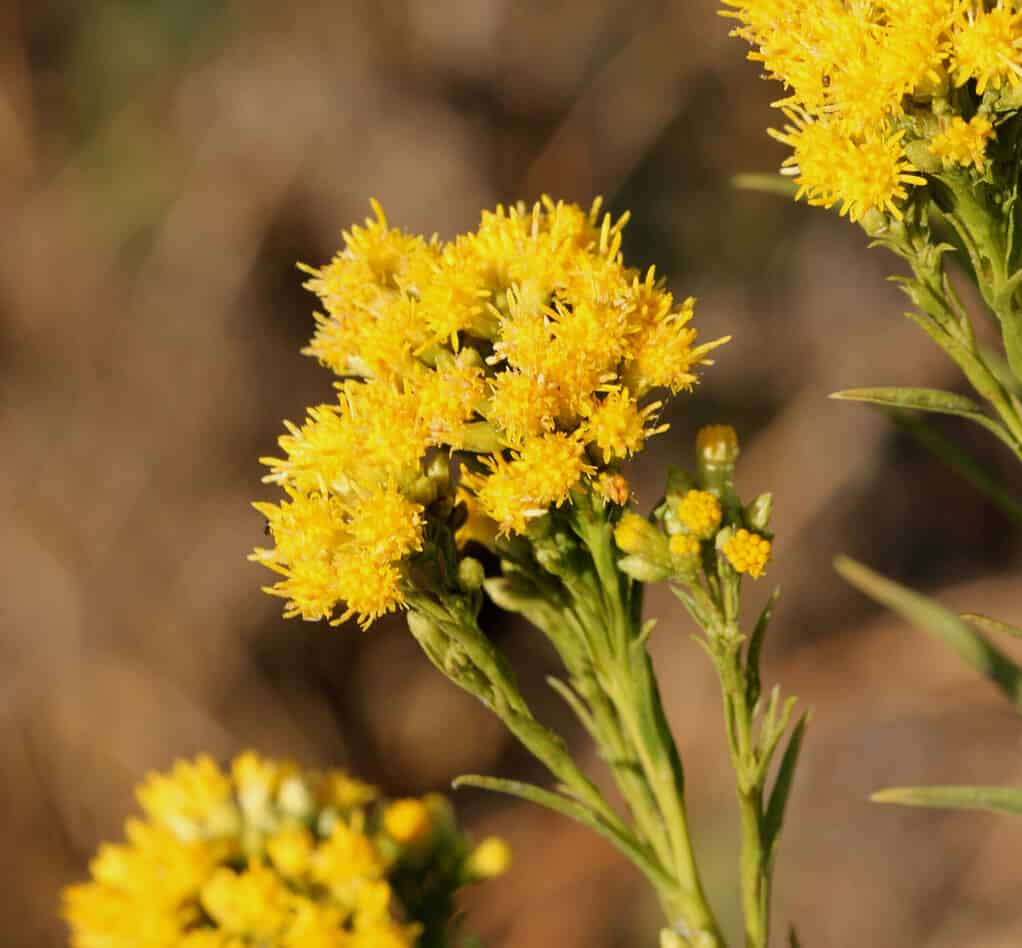
This gorgeous yellow perennial flower grows throughout Northern California and will attract many pollinators to your garden.
©Gurcharan Singh/Shutterstock.com
The western goldentop is another amazing flower choice for gardeners in Northern California. This perennial grows from rhizomes and features tall, branching stems covered with elongated, gray-green leaves. From mid-summer to autumn, it blooms with vibrant yellow flower clusters that sit flat atop its stems.
This plant is a popular food source for pollinators such as bees and butterflies, and it’s recognized as a significant nectar source for monarchs in the Rocky Mountain and Californian coastal areas. It’s native to the western parts of North America, stretching from Nebraska to California.
The western goldentop offers a striking pop of color in the later parts of the year, and it can also spread in favorable conditions. However, with the proper care, it won’t disrupt native plants in the vicinity.
It thrives most in sunny spots with soil that stays moist but drains well. If you’re considering planting this flower, the best time to sow it outdoors ranges from fall to early spring.
11. Sticky Purple Geranium (Geranium viscosissimum)
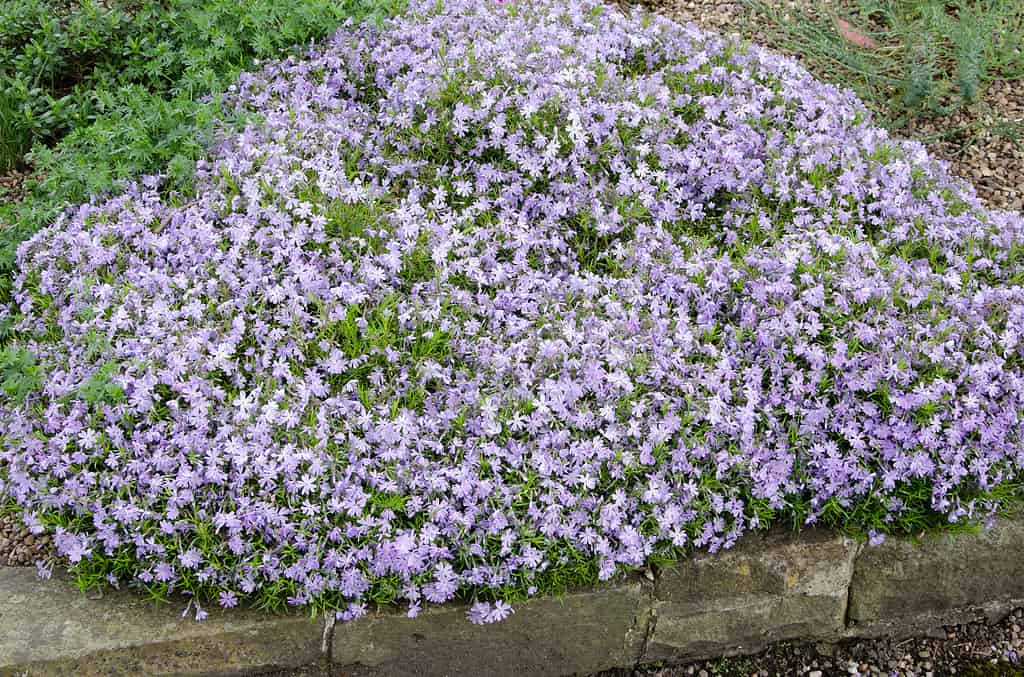
This flower is actually edible and can be eaten raw in salads or used as a garnish!
©Bryony van der Merwe/iStock via Getty Images
The sticky purple geranium is a perennial that sheds its leaves seasonally. It has uniquely lobed leaves that split into 5-7 pointed segments. From late spring to summer’s end, this plant is decorated with small blossoms of a pinkish-lavender color. That said, some plants will display darker flowers with a more purple color. Each flower, about an inch wide, showcases intricate purple lines and a fuzzy texture and is presented in open groupings.
Historically, Native Americans utilized the roots and leaves of this plant for remedying ailments like colds or soothing irritated eyes. Requiring minimal additional watering, the sticky purple geranium remains appealing throughout its growth period, making it a top pick for eco-friendly city gardens.
Fun fact: the blossoms of the sticky purple geranium are safe to eat! They can enhance the flavor of salads or act as a decorative garnish.
For best results, place this plant in an area with full sunlight or partial shade. It prefers soil that’s moderately dry to moist with good drainage. Planting between March and May ensures the geranium settles well before the heat peaks, blessing you with colorful blooms all summer.
12. Showy Goldeneye (Heliomeris multiflora)
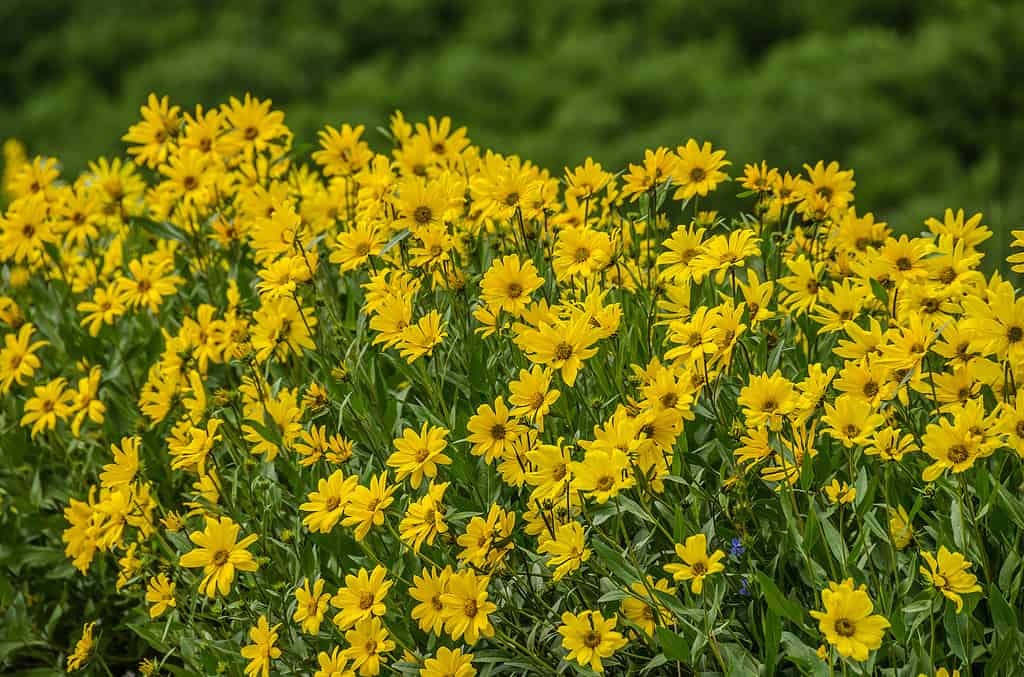
Showy goldeneye is also known as false goldeneye and is a member of the sunflower family.
©suesmith2/iStock via Getty Images
The showy goldeneye is a standout perennial that grows in an upright manner with firm stems. From midsummer to fall, it presents flowers resembling sunflowers, measuring about 1.5 inches wide. Each flower consists of bright yellow petals encircling a bronze-yellow middle, which attract various pollinators, including butterflies and birds.
Its stems are adorned with leaves that range from broad to slender lance-like shapes, with a slight edge and spanning 1-3 inches in length. With origins in Mexico and the western U.S., the showy goldeneye enriches gardens with its abundance of radiant daisy-like flowers over an extended period.
This hassle-free plant offers vibrant color during the heart of summer. Known for its resilience and ease of care, it’s a splendid choice for Northern California gardens.
For optimal growth, it prefers sunny locations and soil that ranges from average dryness to moderate moisture, with good drainage. A robust plant, the showy goldeneye isn’t picky about the ground it calls home; it thrives in diverse conditions, from nutrient-lacking and arid soils to rocky terrains.
If planting from seed, it’s best to do so in late fall.
Summary of Best Perennial Flowers for Northern California
| Number | Flower | Blooming Period |
|---|---|---|
| 1 | Yerba Mansa | Late spring to early fall |
| 2 | Elk Clover | Mid-summer to early fall |
| 3 | Showy Milkweed | Late spring to early summer |
| 4 | Elegant Cluster-Lily | Late spring to mid-summer |
| 5 | Beach Primrose | Early spring to mid-summer |
| 6 | Cobwebby Thistle | Early spring to late summer |
| 7 | Umbrella Plant | Early spring to summer |
| 8 | Californian Cyclamen | Mid-spring to early summer |
| 9 | Seaside Daisy | Mid-spring to summer |
| 10 | Western Goldentop | Mid-summer to fall |
| 11 | Sticky Purple Geranium | Late spring to late summer |
| 12 | Showy Goldeneye | Mid-summer to fall |
The photo featured at the top of this post is © suesmith2/iStock via Getty Images
Thank you for reading! Have some feedback for us? Contact the AZ Animals editorial team.







